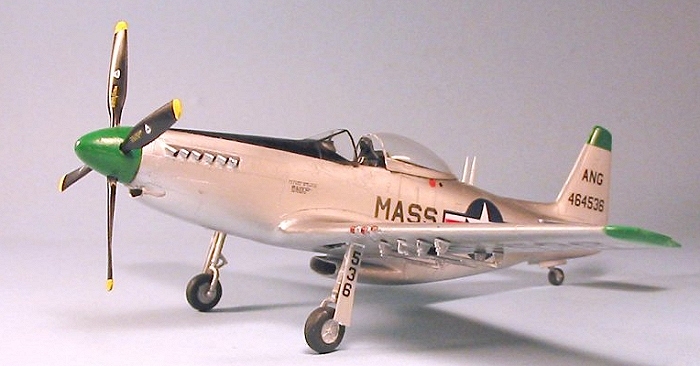
Classic Airframes 1/48 F-51H Mustang
| KIT #: | ? |
| PRICE: | $24.99 when new |
| DECALS: | Two options |
| REVIEWER: | Tom Cleaver |
| NOTES: | Long out of production |

| HISTORY |
The original Allison-powered Mustang was a lightweight fighter with excellent handling capability. Pilots I know who have had the opportunity to fly these early Mustangs and compare them with the later Merlin-powered P-51B and P-51D uniformly agree that the early Mustang flies better. With the addition of more armor, more armament and more fuel - even with a more powerful engine - the Mustang gave a much heavier feel, which did affect its maneuverability.
North American was aware of this during the aircraft’s original wartime
development, and put considerable effort into trying to come up with a
lightweight Mustang that gave the maneuverability of the earlier models
with the altitude performance and range of the later models. The XP-51F
and XP-51G were the result. Using the same Merlin V-1650-7 engine as the
P-51D, the loaded weight of the airplane was reduced to 9,060 pounds - as
compared to a loaded weight of 10,100
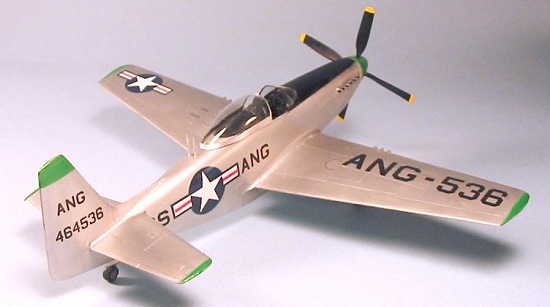 pounds for the P-51D. This was
accomplished through simplification of the structure, the deletion of some
equipment, and the use of new materials such as plastics, while
aerodynamics were improved with a longer bubble canopy. The net result was
a savings of 2,000 pounds and a top speed of 466 mph. The XP-51G was fitted
with the Merlin 145 engine and achieved a top of 472 mph.
pounds for the P-51D. This was
accomplished through simplification of the structure, the deletion of some
equipment, and the use of new materials such as plastics, while
aerodynamics were improved with a longer bubble canopy. The net result was
a savings of 2,000 pounds and a top speed of 466 mph. The XP-51G was fitted
with the Merlin 145 engine and achieved a top of 472 mph.
Development of the lightweight Mustang resulted in the P-51H, which entered production towards the end of 1944. Equipped with a Packard-Merlin V-1650-9 delivering a maximum 2,218 horsepower (as opposed to the maximum 1,695 horsepower of the P-51D), the maximum range of 1,000 miles on internal fuel could be extended to 1,500 miles with two 75-gallon drop tanks. The P-51H had a shorter “bubble” canopy than the XP-51F/G, and a full 6-gun armament, the overload weight of 10,500 pounds was only a few hundred less than the P-51D. Nevertheless, it was the fastest production P-51, with a top speed of 487 mph. 1,445 P-51Hs were ordered in January 1945, but the end of the war in August brought production to a halt with a total of 555 aircraft.
The P-51H, along with the P-47N, equipped the postwar Air National Guard as jets replaced propeller-driven fighters in the U.S. Air Force. The V-1650-9 Merlin - which was close to being a “race” engine similar to the bored-out engines that power P-51Ds in air races to this day was as temperamental as those engines, which resulted in units equipped with the P-51H seldom experiencing more than 50% availability. This more than anything else was responsible for the P-51H not being called to active duty during the Korean War.
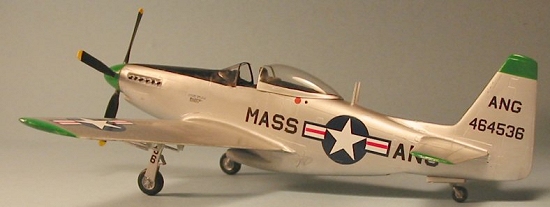 By
the 1970s, only two P-51Hs were left in flyable condition. One of these
was owned by Mike Coutches of Oakland, California, and was regularly flown
at west coast air shows. The other was eventually purchased by the two
biggest morons to ever participate in American aviation: Bill and Don
Whittington. The continued existence of these two is the best argument
against inherited wealth I know of, and is proof there is no connection
whatsoever between the brain and the billfold. Together, these two
incompetents were responsible in the late 1970s and early 1980s for more
otherwise-avoidable losses of warbirds and unlimited racers than the rest
of the community combined, and in each case the fault for the loss could be
laid to obvious pilot error. In 1981, I watched one of these two idiots (I
forget which) blow the engine of their P-51H and then, through failure to
trade airspeed for altitude that would have given him time and distance to
make the field for a deadstick landing, instead land the airplane too fast
wheels-up in the desert, turning it into immediate scrap. There are those
who say the airplane - which is still in some hangar in Florida - may yet
be rebuilt by some multi-millionaire like Kermit Weeks, but as of the last
time I heard of it, it was still moldering away.
By
the 1970s, only two P-51Hs were left in flyable condition. One of these
was owned by Mike Coutches of Oakland, California, and was regularly flown
at west coast air shows. The other was eventually purchased by the two
biggest morons to ever participate in American aviation: Bill and Don
Whittington. The continued existence of these two is the best argument
against inherited wealth I know of, and is proof there is no connection
whatsoever between the brain and the billfold. Together, these two
incompetents were responsible in the late 1970s and early 1980s for more
otherwise-avoidable losses of warbirds and unlimited racers than the rest
of the community combined, and in each case the fault for the loss could be
laid to obvious pilot error. In 1981, I watched one of these two idiots (I
forget which) blow the engine of their P-51H and then, through failure to
trade airspeed for altitude that would have given him time and distance to
make the field for a deadstick landing, instead land the airplane too fast
wheels-up in the desert, turning it into immediate scrap. There are those
who say the airplane - which is still in some hangar in Florida - may yet
be rebuilt by some multi-millionaire like Kermit Weeks, but as of the last
time I heard of it, it was still moldering away.
| THE KIT |
The Classic Airframes P-51H was one of two 1/48 P-51H kits released in
1999, the other being by a company whose products are so bad I have managed
to put their name completely out of my mind, of which their P-51H was the
worst of a line of awful kits that finally resulted in them going out of
business. (That would be the
HiPM
kit. Ed) The only thing I can recall of that kit was that it only
vaguely resembled a P-51H, and was one of the few plastic kits I have ever
built that not only was  thrown against a wall but was stomped into its
component atoms. Fortunately, I did keep the decal sheet, the one good
thing in the box, which was put to use with this project several years
later.
thrown against a wall but was stomped into its
component atoms. Fortunately, I did keep the decal sheet, the one good
thing in the box, which was put to use with this project several years
later.
The Classic Airframes P-51H was really not much better, though it was at least dimensionally accurate. It comes from the days when people used to use “Classic Airframes” as a sort of a swear word, due to kits that were frequently more than a bit “challenging” (remember the D.XXI and the first Defiant?) Fortunately, Classic Airframes has gone onward and upward, and today produces kits that are still challenging, but result in good models.
Their P-51H is still the only 1/48 kit of this airplane available, if you can find it on a dealer’s table at a model show. I had built one when it first came out, done in the kit markings as Experimental Aircraft Foundation founder Paul Poberezny’s Wisconsin ANG airplane, which is now on display out at Planes of Fame Air Museum. I forget where I got this second kit, but it sat in the stash untouched for several years until I obtained the Falcon Vacuform set “Mustang Special”, which includes an accurate P-51H canopy made for the kit.
| CONSTRUCTION |
Break out the Bondo and the Mr. Surfacer before opening this kit, and be sure you have fresh sanding sticks, because you are going to use everything to get to the finish line.
First, I took the parts off the sprues and spent a good bit of time cleaning them up and getting rid of the flash.
 I
first assembled the wing, gluing the main wheel doors closed, since these
are only open on a P-51H when the gear is operating up and down. I applied
putty to the door area and sanded it smooth, then rescribed the outline of
the doors.
I
first assembled the wing, gluing the main wheel doors closed, since these
are only open on a P-51H when the gear is operating up and down. I applied
putty to the door area and sanded it smooth, then rescribed the outline of
the doors.
After taking the resin cockpit main assembly off its pour stub, I assembled the resin cockpit per instructions and painted it black, the postwar color for Mustang cockpits.
I took a sanding stick and sanded the too-thick dorsal fit to about half thickness - working on it from the centerline and the external surface - since the dorsal fin on a P-51H is very thin. I also sanded along the centerline of the fuselage to narrow it a bit so it would fit to the wing subassembly eventually, and so the vertical fin would be thin with a sharp trailing edge.
I then assembled the fuselage, and then attached the wing sub-assembly. Putty was required on all joints, with a lot of sanding to get things smooth, followed by Mr. Surfacer 500 to get finally rid of the seams. I then polished the model and rescribed all the panel lines. With the horizontal stabilizers attached, and the vacuform windscreen in position with its seam filled, the model was ready to paint.
| COLORS & MARKINGS |
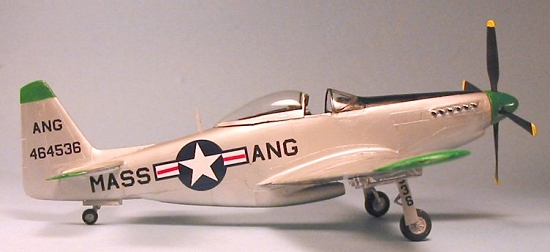 Painting:
Painting:
While the P-51H originally entered service in a natural metal finish, when it went to the Air National Guard it was one of the first airplanes to be painted overall with aluminum lacquer for anti-corrosion protection. I first painted the model with the black anti-glare area and the Kelly-Green squadron colors, then applied SNJ Aluminum with a coat of Model Master Sealer, which makes the aluminum paint look like paint rather than metal.
Decals:
I used the kit decals for the national insignia, and the decals from the HiPM (There, I remembered it) kit to do a Mustang of the Massachusetts Air National Guard.
| FINAL CONSTRUCTION |
I used the bomb rack and rocket rails from a Hasegawa P-51D kit, and then attached the canopy in the open position. I had already sanded down the too-thick prop blades, and attached them to the prop spinner.
| CONCLUSIONS |
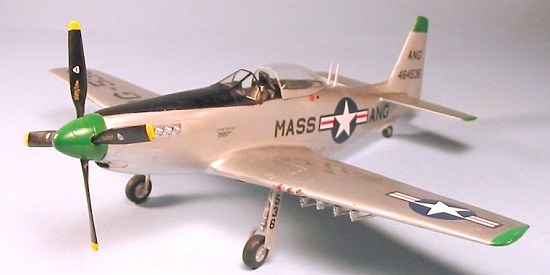 If you’re a Mustang fan and want the last P-51 in your collection, the
Classic Airframes kit is the only game in town (unless you are really nuts
and willing to shell out over $100 for the Collectaire kit, which is not
that much better), if you can get it. It definitely is a kit where “some
modeling skill required” is the minimum. A vacuform would likely be
easier, and if you’re waiting for a “state of the art” kit of this rare
Mustang, don’t hold your breath or you’ll turn blue and die. Another one
is unlikely, but I never say “never.” Trumpeter might yet surprise us.
If you’re a Mustang fan and want the last P-51 in your collection, the
Classic Airframes kit is the only game in town (unless you are really nuts
and willing to shell out over $100 for the Collectaire kit, which is not
that much better), if you can get it. It definitely is a kit where “some
modeling skill required” is the minimum. A vacuform would likely be
easier, and if you’re waiting for a “state of the art” kit of this rare
Mustang, don’t hold your breath or you’ll turn blue and die. Another one
is unlikely, but I never say “never.” Trumpeter might yet surprise us.
April 2005
Copyright ModelingMadness.com. All rights reserved. No reproduction in part or in whole without express permission.
If you would like your product reviewed fairly and quickly, please contact the editor or see other details in the Note to Contributors.